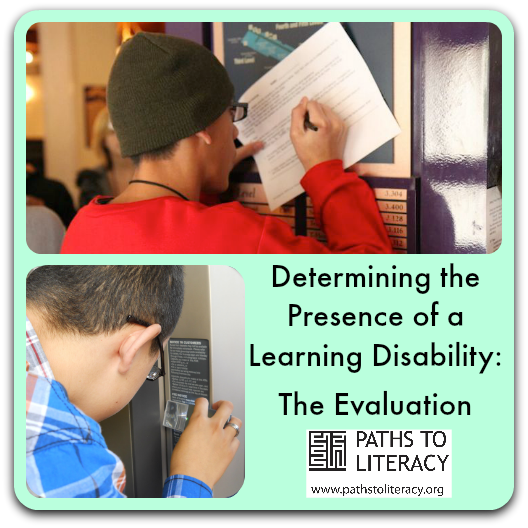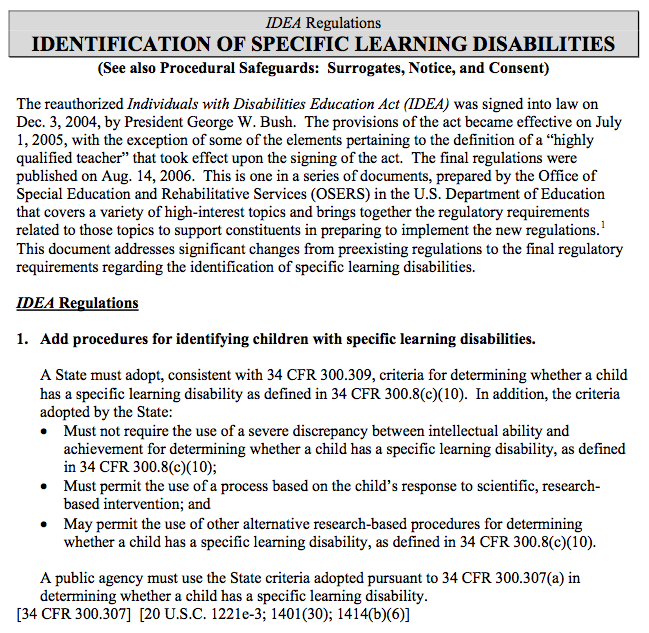Determining the presence of a specific learning disability is a complex process. Most parents and Teachers of Students with Visual Impairments (TVIs) have a general idea of the procedure, but it is important to know several things about the process. These include:
- Federal regulations that form the base for all state-mandated procedures
- Questions that may arise during the initial referral for evaluation
- Evaluation procedures that will occur
Federal Regulations

Learning disabilities (LD) are among the conditions that are broadly defined by the Individual with Disabilities Education Act (IDEA) which was revised and reauthorized in July 2004. A comprehensive explanation of the changes and overview of the portions relating to LD is attached. It is important to note that the IDEA gives state broad information about the conditions as well as eligibility requirements. However, each state will develop more specific information about ways that LD must be determined in their state. The information in this post presents specific information about procedures that represent “best practice guidelines.” It is important that any parent or TVI advocating for such an evaluation know the specific guidelines in their state.
LD is defined as problems in specific areas of learning. These currently include the following:
- Oral expression
- Listening comprehension
- Basic reading
- Reading fluency
- Reading comprehension
- Math calculation
- Math problem solving
By definition, a LD indicates that a student is having specific difficulties in an area that would not be expected based upon their overall level of abilities. It also indicates that this problem is not PRIMARILY the result of a physical, intellectual, or emotional problem, or lack of experience or educational intervention.
Two major changes are noted in the revised IDEA. The first is an increased emphasis on the presence of intense interventions that are research-based in nature. There is also a requirement that the results of this intervention be documented through regular assessments. Students who are struggling with particular areas of learning are to be identified early in their school career, and good intervention by qualified teachers must be provided.
The second involves the prohibition of the “discrepancy model” as the sole determining factor in identifying LD as an additional eligibility. The discrepancy model is based upon determining the difference between the statistical scores on an IQ test and an Achievement test. If the discrepancy was sufficiently great, the evaluator would determine that the student had a LD. This model presents many problems, but overall it likely resulted in a significant difficulty in accurately identifying students with LD in many cases. There is still a requirement that the evaluator determine that the student is achieving below their potential, but there is more latitude in ways that this may be determined.
Another change in the IDEA is more subtle. There is a greater emphasis on a Multidisciplinary Team (MDT) process with the regular education teacher and parents being included as part of the decision-making. The inclusion of the TVI is not specifically stated, but would certainly be an obvious extension with the current language.
Questions that May Arise
When a MDT refers a student for an evaluation to determine the presence of LD, there are several questions that arise for all students. Such questions must be addressed prior to the evaluation. If there are questions about the provision of an educational program or interventions, the evaluation may be postponed. Additionally, if there are questions about other conditions being the primary cause of the difficulties, the evaluation may be postponed. Specific questions that may be asked include the following:
Are there data that support the regular attendance of the student in school in order to participate in an educational program?
If there are patterns of excessive absences, the evaluation will likely be postponed until the student has established regular attendance. The IDEA is very clear in indicating that educational experiences must have occurred. If there have been significant absences even for approved health issues, an evaluation for LD is likely not appropriate.
Has an appropriate educational program been provided?
This question addresses not only participation in the regular education classroom but also the provision of appropriate intervention. For the student with VI, the question also addresses the provision of appropriate VI services. If there have been significant lengths of time without VI services even because of legitimate personnel issues, an evaluation for LD is likely not appropriate.
Have appropriate interventions occurred as well as regular assessments to determine progress?
Many schools have specific teachers who provide instruction specific to an area of need. The purpose of these types of classes is to provide the best possible intervention with smaller teacher/student ratios. Data are maintained by these teachers, and it is possible to track the rate and type of progress. This type of intervention is often provided by the TVI rather than a curriculum/content specialist. If there are no data to indicate that this type or intervention has occurred or to track progress, an evaluation for LD is not likely to occur.
How can we determine that eligibility is not the PRIMARY cause of the learning problems?
Evaluation Procedures
Resources for Understanding the Student with VI
In recent years there have been significant changes in relationship to the evaluation of students with VI. There are more publications and information available about this topic through books and websites. Increased emphasis on low-incidence populations is apparent in graduate school. New formal evaluation instruments are available for the students with VI. One of the important advocacy goals for any TVI or parent of a child with visual impairment is to keep up with this information through professional and support groups. The other is to share this information with other educators and evaluators as they need it. Avoid the temptation to overwhelm them with data. Keep references organized and succinct so that the evaluator can find them easily.
Understanding the Evaluation Process
The following information presents some specific data about what might occur during an evaluation for LD. This represents a fairly typical pattern for most evaluations as conducted by a specialist, most typically a school psychologist. It is important to note that the individual school psychologist doing the evaluation will be a source for much more specific information. If you are the TVI or the parent, it would be useful to set up an appointment before the evaluation to talk about what is involved, when the evaluation will start, and how you can help. Prepare your questions before you meet or talk by phone. Most school psychologists are eager to explain the process fully. Most of us have done these evaluations so often that we may simply forget what is new territory for parents and other teachers.
Typical Structure of an Evaluation for LD
An evaluation for LD usually consists of a combination of observation, interview, informal evaluations, and formal evaluations. Again the specific procedures followed and tests administered will vary with the state of residence as well as questions to be addressed. Almost all states will require some variation on this pattern of data.
Observations
Typically an observation will be completed by the evaluator while the student is in different environments. The goal is to observe a number of different things such as independent work skills, social interactions, ability to initiate tasks, problem-solving skills, ability to self-initiate, organizational skills, etc. Occasionally this will be done using a formal instrument, but these are often done informally. The goal is often to discover if other factors are affecting the ability to learn. For example, is the student having difficulty in initiating tasks because he is disorganized?
Interviews
Most evaluations for the presence of LD will involve an interview of the teachers working with the student as well as the parent. The goal is to gain information about everyday performance and behavior of the student. These results may indicate that a student is becoming increasingly frustrated, is often distracted and off-task, or working diligently to meet expectations. This information can help tremendously in determining the subsequent steps in providing an education for the student.
Interviews with the student are also helpful. They provide information about areas in which they feel competent, as well as those areas that are frustrating to them. Older students may also have insight about specific areas that are difficult for them, and most efficient ways for them to learn.
Informal Evaluations
Each evaluator almost certainly has some informal techniques/evaluations that they use to obtain additional information. This may include techniques as diverse as recording the reading speed, assessing efficiency at use of adaptive devices, keyboarding speeds, and comprehension of leisure reading. In my own evaluations, I always ask the student to explain their visual impairment as well as the implication that it has within their home and school environment. All of these data will help develop an evaluation that presents a rich summary of an individual child.
Formal Evaluations
Another group of formal evaluations consist of rating scales that parents and teachers are asked to complete. These scales may focus upon behavior, the ability of the child to complete tasks around the home, their independence with homework, etc. TVIs and parents should be certain to follow instructions for completion carefully. One of the more critical factors is to have the rating scales completed by the deadline. The other important issue is to be certain that all questions are answered thoroughly with the most current information. Do not spend a great deal of time analyzing the question. Usually your first impulse for response is the most accurate. For example, don’t indicate that your child is independent at getting ready for school if you are still being certain that she has her lunch, homework, and prompting her out the door when the bus arrives. If in school the the student requires constant prompts to get work tuned in, state that. Reflect the support that you currently give so that all can help her grow to the independence you want her to show.
Evaluations for LD or any other eligibility can be stressful. Understanding the reason for the evaluation, procedures that will be used, and questions that are often raised will help it be less stressful for parents, TVI, and most importantly the student.








